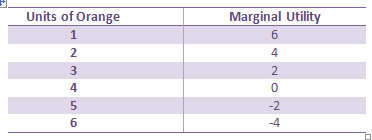The law of diminishing marginal utility was first propounded by 19th century German economist H.H. Gossen which explains the behavior of the consumers and the basic tendency of human nature. Hence, this law is also known as Gossen’s First Law. This was further modified by Marshall.
According to Marshall,
The additional benefit a person derives from a given increase of his stock of anything diminishes with the growth of the stock that he already has.
According to Paul A. Samuelson,
As the amount consumed of a good increases, the marginal utility of the good leads to decrease.
As per the definitions, we can conclude that, if the consumer consumes goods continuously, the utility obtained from every successive unit goes on diminishing. If the consumer is consuming the goods continuously, firstly he reaches the point of maximum satisfaction which is known as level of satiety. If he continues to consume the goods again, the utility obtained from that particular goods goes in negative aspect or he gets inutility.
[Related Reading: Concept of Utility: Cardinal and Ordinal Utility]
Law Of Diminishing Marginal Utility Assumptions
- The consumer who is consuming the goods should be logical and knowledgeable to consume every unit of goods.
- The goods which are to be consumed should be equal in size and shape.
- Consumer should consume the goods without time gap.
- The consumer’s income, preference, taste and fashion should not be changed while consuming the goods.
- To hold the law good, utility should be measured in countable units or cardinal numbers. The utility obtained from those goods is measured in ‘utils’ unit.
- As we know that money is the measuring rod of utility, being so, marginal utility of money should remain constant during consumption of the goods.
Example to Demonstrate Law of Diminishing Marginal Utility
This law can be illustrated with the help of a table shown below:

The table shows that when a consumer consumes 1st unit of orange he derives the marginal utility equal to 6utils. As the consumer consumes 2nd and 3rd units of orange, the marginal utility is declined from 4utils to 2utils respectively.
When he consumes 4th unit of orange the marginal utility becomes zero, which is called the point of satiety. Similarly, from the consumption of 5th and 6th units of orange, the marginal utility becomes negative, i.e., he gets disutility instead of utility from these units of consumption.
Thus, the table shows that a consumer consumes more and more units of a commodity at a certain period of time, the marginal utility declines, becomes zero and even negative.
This law can be further explained with the help of a diagram:

In the figure, X-axis represents units of orange and Y-axis represents utility. MU is the marginal utility curve which slopes downward from left to right. It means that as a consumer consumes more and more units of a commodity, the marginal utility he derives from the additional unit of consumption goes on declining, becomes zero(at point D) and even negative(at point E and F.)
[Related Reading: Principle of Marginal Rate of Substitution]
Exceptions Where Law of Diminishing Marginal Utility Doesn’t Apply
Dissimilar units
This law is applicable for homogenous unit only, i.e. only if all units of a commodity consumed are similar in length, breadth, shape and size. If there is a change in such factors, the utility obtained from it can be increased. For example: If the 2nd orange is much larger than the 1st one, it will yield more satisfaction than the 1st.
Unreasonable quantity
The quantity of the commodity a consumer consumes should be reasonable. If the units of consumption are too small, then every successive unit of consumption may give higher utility to the consumer. For example: If a person is given water by a spoon when he is very thirsty, each additional spoonful will give him more satisfaction.
Not a suitable time period
There should not be very long gap between the consumption of different units of the commodity. If there is time lag between the consumption of different units, then this law may not hold good. For example: If a man has lunch at 10 a.m. and dinner at 8 p.m. and eats nothing in between, the dinner will possibly yield even more satisfaction than the lunch, i.e. his marginal utility will not diminish.
Rare collection
This law does not apply for rare collections such as old coins, stamps and so on because the longer and larger the number he collects, the greater will be the utility.
Change in taste and fashion of the consumer
The law of diminishing marginal utility will be applicable only if the consumer is not supposed to change taste and fashion of the commodity whatever he/she was using previously.
Abnormal person
The law of diminishing marginal utility is applicable for normal person only. Abnormal persons such as drunkards and druggist are not associated with the law.
Change in income of the consumer
To hold the law good, there should not be any change in the income of the consumer. If the income of the consumer increases, he will consume more and more units of a commodity which he prefers. As a result, utility can be increased rather than decreased.
Habitual goods
The law will not be applicable for habitual goods such as consumption of cigarettes, consumption of drugs, alcohol, etc.
Durable and valuable goods
The law is not applicable in case of durable goods as well as valuable goods such as buildings, vehicles, gems, gold, etc.
